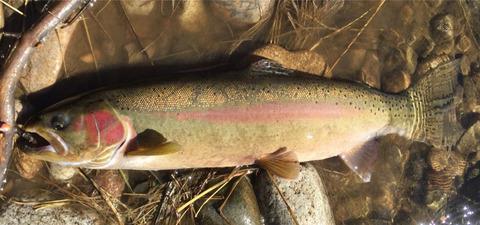当前位置:
X-MOL 学术
›
Ecol. Evol.
›
论文详情
Our official English website, www.x-mol.net, welcomes your
feedback! (Note: you will need to create a separate account there.)
Contemporary genetic structure affects genetic stock identification of steelhead trout in the Snake River basin
Ecology and Evolution ( IF 2.3 ) Pub Date : 2020-08-28 , DOI: 10.1002/ece3.6708 John H Powell 1 , Matthew R Campbell 1
Ecology and Evolution ( IF 2.3 ) Pub Date : 2020-08-28 , DOI: 10.1002/ece3.6708 John H Powell 1 , Matthew R Campbell 1
Affiliation

|
Genetic stock identification is a widely applied tool for the mixed‐stock management of salmonid species throughout the North Pacific Rim. The effectiveness of genetic stock identification is dependent on the level of differentiation among stocks which is often high due to the life history of these species that involves high homing fidelity to their natal streams. However, the utility of this tool can be reduced when natural genetic structuring has been altered by hatchery translocation and/or supplementation. We examined the genetic population structure of ESA‐listed steelhead in the Snake River basin of the United States. We analyzed 9,613 natural‐origin adult steelhead returning to Passive Integrated Transponder detection sites throughout the basin from 2010 through 2017. Individuals were genotyped at 180 single nucleotide polymorphic genetic markers and grouped into 20 populations based on their return location. While we expected to observe a common pattern of hierarchical genetic structuring due to isolation by distance, we observed low genetic differentiation between populations in the upper Salmon River basin compared to geographically distant populations in the lower Snake River basin. These results were consistent with lower genetic stock assignment probabilities observed for populations in this upper basin. We attribute these patterns of reduced genetic structure to the translocation of lower basin steelhead stocks and ongoing hatchery programs in the upper Salmon River basin. We discuss the implications of these findings on the utility of genetic stock identification in the basin and discuss opportunities for increasing assignment probabilities in the face of low genetic structure.
中文翻译:

现代遗传结构影响蛇河流域硬头鳟鱼遗传资源鉴定
遗传种群识别是整个北太平洋沿岸鲑科鱼类混合种群管理中广泛应用的工具。遗传种群鉴定的有效性取决于种群之间的分化水平,由于这些物种的生活史涉及对其出生流的高度归巢保真度,这种分化水平通常很高。然而,当自然遗传结构因孵化场易位和/或补充而改变时,该工具的效用可能会降低。我们研究了美国斯内克河流域列入欧洲航天局 (ESA) 名单的虹鳟的遗传种群结构。我们分析了 2010 年至 2017 年返回整个流域被动集成应答器检测点的 9,613 只自然来源的成年硬头鱼。对个体进行了 180 个单核苷酸多态性遗传标记的基因分型,并根据其返回位置分为 20 个种群。虽然我们预计会观察到由于距离隔离而导致的等级遗传结构的共同模式,但我们观察到,与蛇河下游流域地理上相距较远的种群相比,萨蒙河流域上游种群之间的遗传分化较低。这些结果与在该上游盆地种群中观察到的较低遗传种群分配概率一致。我们将遗传结构减少的这些模式归因于下游盆地硬头鱼种群的易位和上游鲑鱼河流域正在进行的孵化计划。我们讨论了这些发现对流域遗传种群鉴定的影响,并讨论了在遗传结构较低的情况下提高分配概率的机会。
更新日期:2020-10-12
中文翻译:

现代遗传结构影响蛇河流域硬头鳟鱼遗传资源鉴定
遗传种群识别是整个北太平洋沿岸鲑科鱼类混合种群管理中广泛应用的工具。遗传种群鉴定的有效性取决于种群之间的分化水平,由于这些物种的生活史涉及对其出生流的高度归巢保真度,这种分化水平通常很高。然而,当自然遗传结构因孵化场易位和/或补充而改变时,该工具的效用可能会降低。我们研究了美国斯内克河流域列入欧洲航天局 (ESA) 名单的虹鳟的遗传种群结构。我们分析了 2010 年至 2017 年返回整个流域被动集成应答器检测点的 9,613 只自然来源的成年硬头鱼。对个体进行了 180 个单核苷酸多态性遗传标记的基因分型,并根据其返回位置分为 20 个种群。虽然我们预计会观察到由于距离隔离而导致的等级遗传结构的共同模式,但我们观察到,与蛇河下游流域地理上相距较远的种群相比,萨蒙河流域上游种群之间的遗传分化较低。这些结果与在该上游盆地种群中观察到的较低遗传种群分配概率一致。我们将遗传结构减少的这些模式归因于下游盆地硬头鱼种群的易位和上游鲑鱼河流域正在进行的孵化计划。我们讨论了这些发现对流域遗传种群鉴定的影响,并讨论了在遗传结构较低的情况下提高分配概率的机会。











































 京公网安备 11010802027423号
京公网安备 11010802027423号